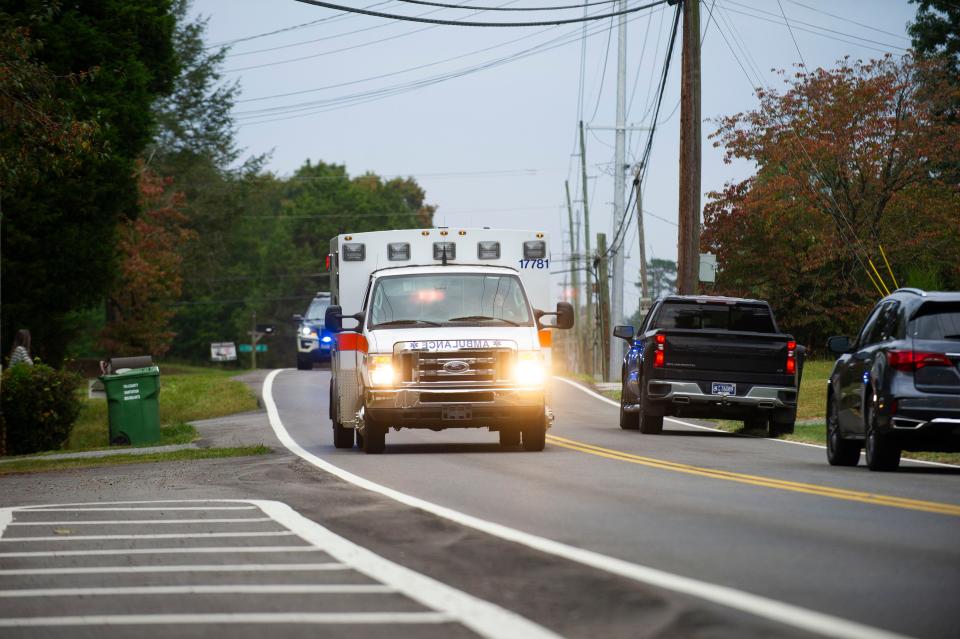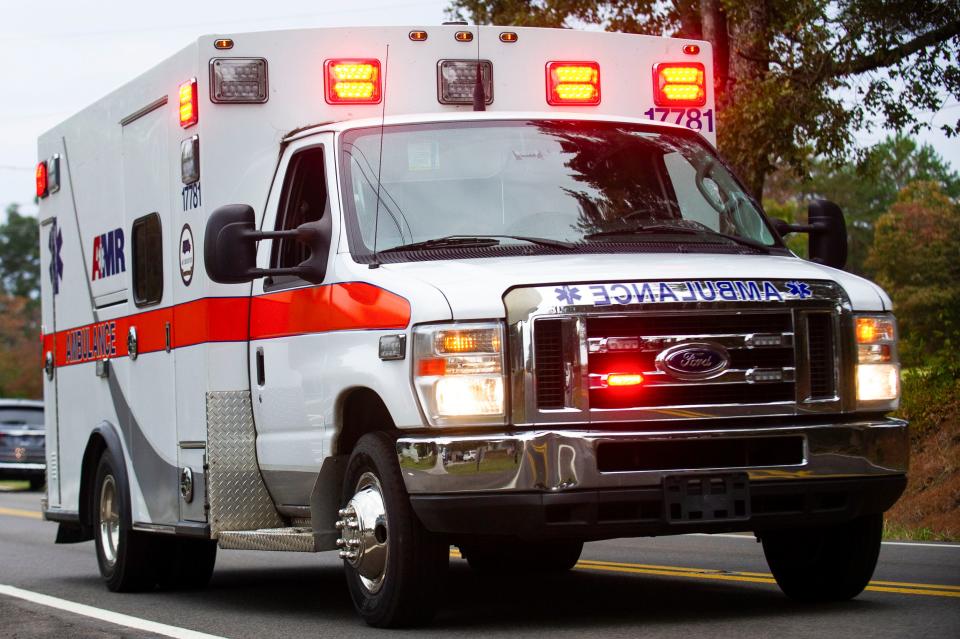Why doesn't Knox County just run its own ambulance service? | Know Your Knox
The Knox County Commission’s decision on a new ambulance service contract has homeowners rethinking the importance of who shows up when you dial 911 – and how long it takes them to get there.
Commissioners voted Nov. 20 to rehire American Medical Response to continue providing ambulance service to the county. The new contract, which goes into effect Feb. 1, has provisions that seek to reduce wait times, but it comes at a cost to taxpayers.
The vote came as current contractor American Medical Response has struggled mightily to keep up with demand, to the point where the delays prompted Knoxville police spokesman Scott Erland to tell Knox News in October "there’s no guarantee an ambulance will show up quickly or at all."
Related: Six Knox County commissioners took $500 campaign donations from ambulance company
There are many theories on how to fix the problem, but one question rises to the top: Why doesn’t Knox County run its own ambulance service?
Tennessee counties weren't required to provide ambulance service until 2021
It wasn’t until 2021 that the state of Tennessee added ambulance service as an essential service, requiring counties to provide ambulances – either themselves or through a contract with a third party. Before then, ambulance service was like fire service: some counties offered it and some didn’t (think volunteer fire departments like Seymour Volunteer Fire Department and others in surrounding rural communities).
Former Knox County Finance Director Kathy Hamilton said the possibility of the county adding ambulance service wasn’t raised as a serious idea when she had the job from 1989 to 2002.

“To my recollection, there was never a discussion of adding an ambulance service,” she wrote in an email. “Like fire protection, it would have been something that would have been an added service and we would have had to find the revenue to fund it. We tried with fire services – you probably remember the efforts to set up a fire district. Once that effort failed, I’m sure it would have been seen as a reason not to consider adding ambulance services.”
The history of ambulance service in Knox County
Rick Harrington is a local historian of sorts when it comes to ambulance services. He has worked for one provider or another since 1971. Since 1984 he's worked in various capacities at LIFESTAR, the air ambulance service centered at the University of Tennessee Medical Center. Over the years he has given PowerPoint presentations on the history of emergency medical services for local providers.
The local ambulance industry, Harrington said, began like it did in most communities, with funeral homes providing the service for years until regulations and health advances caught up with the industry in the 1960s-'70s.
From there, the Knox County Ambulance Authority was created and contracted with a company from North Carolina, Harrington said. During this time, Knox County Rescue ran an ambulance for a time, as did the Knoxville Fire Department, though both services were limited.
The West Knoxville Fire Department formed in 1964, Rural Metro Fire chief Jerry Harnish told Knox News. In 1977, the name was changed to Rural Metro Fire Department, but the outfit didn’t start providing ambulance service until 1985, when the company won the EMS bid, he said.
That 1985 bid came after the county contracted with East Tennessee Emergency Medical Service, formerly the Maryville Alcoa Ambulance Service, which got the contract during the 1982 World’s Fair and held it until 1985.
Knox News could not confirm the name of the North Carolina company or whether it held the contract until East Tennessee Emergency Medical Service took over in 1982.
How well do you Know Your Knox? We answer the questions you really want to know

What do other counties do about ambulances?
It’s not unusual for Tennessee counties to operate their own ambulance service, particularly counties with urban centers. Shelby County (Memphis), Davidson County (Nashville) and Hamilton County (Chattanooga) all operate their own service.
Knox News recently detailed Hamilton County’s ambulance service, which began in 1988, and found the costs were similar to what Knox County is expected to pay in its next contract, whether with AMR or another company.
Hamilton County officials included language in their agreements with local hospitals to allow paramedics to offload patients at hospitals instead of requiring them to wait – sometimes for hours – until the patient can be taken to a room. An AMR company policy discourages offloading patients, but officials in Hamilton County said it was necessary.
“It’s not the hospitals’ fault, but we can’t have five trucks waiting two hours,” Hamilton County EMS deputy director Wade Batson told Knox News. “(Hospitals) don’t like it, but at the end of the day, something has got to give.”
How much money are we talking?
Starting an ambulance service from scratch would be expensive at first if Knox County opted to run its own. The initial payout could easily add up to tens of millions of dollars to get a program off the ground from scratch, though there are avenues for substantially reducing those costs to county taxpayers.
Even with a contractor, AMR's proposal will require new subsidies to shorten wait times for patients in need of emergency care. AMR provided two options varying in cost from $2 million to $2.8 million annually, with a 3% annual increase built in.
In the proposed contract, the company would be penalized if a vehicle took longer than 20 minutes for 90% of calls in the county, including Farragut. In the city, the contract calls for a response within 10 minutes for 90% of the calls.
Knox County commissioners have balked at those response times as too long, but reducing times would require more ambulances, and more units and staffers would require more money, potentially a lot more money.
The Hamilton County ambulance system costs about what Knox County will end up paying for its ambulance contract annually. Hamilton County budgeted $17.9 million for EMS for the 2023 fiscal year but softened the financial hit by using $15.7 million in expected revenues from ambulance service, paid mostly by patients' insurers. The direct cost to taxpayers is $2.2 million.
But those are the annual costs to operate a system that already exists. Starting one would mean buying ambulances and hiring skilled medical staffers.
New ambulances, for instance, take at least 18 months to arrive after they're ordered and cost more than $300,000 apiece, according to the Fitch review. AMR runs 18-25 ambulances at peak hours, which means it could cost Knox County upwards of $7.5 million to get started, though used ambulances could be cheaper.
There is also the cost of employee salaries and benefits, and of operating ambulances full time. Those costs, however, could be mostly covered by charges to those who use the services, much like in Hamilton County.
Know Your Knox answers your burning questions about life in Knoxville. Want your question answered? Email knowyourknox@knoxnews.com.
Tyler Whetstone is an investigative reporter focused on accountability journalism. Connect with Tyler by emailing him at tyler.whetstone@knoxnews.com. Follow him on X, formally known as Twitter @tyler_whetstone.
Make our community, our society and our republic stronger by supporting robust local journalism. Subscribe online at knoxnews.com/subscribe.
This article originally appeared on Knoxville News Sentinel: Why doesn't Knox County have its own ambulance service?

